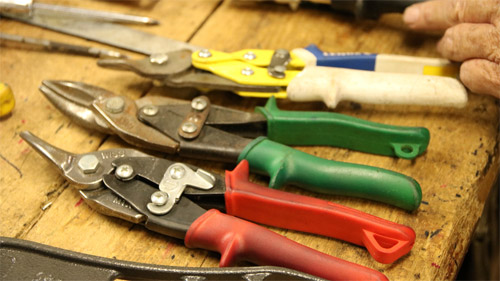If you avoid fully closing the jaws of snips while making cuts in metal, this sheet metal toolbox essential can endure years of consistent use. You also will avoid leaving behind fishhook marks in the metal if you don't close snips all the way.
Leading snips manufacturers tout their patented forging techniques that lead to long blade life, as well as handles that multiply hand force. But regardless of manufacturers, occasionally oiling the pivot bolt and the surrounding contact points will also extend the tool's life.
Jon Olson, learning and product training manager at Malco, suggests sharpening to go one step further.
"To maximize the life of your aviation snips, maintain the cutting edge by lightly sharpening the cutting edge with a stone," Olson said. "This will also remove any zinc build-up left by the galvanized sheet metal."
Offset-right snips from Midwest, Malco and other companies are the most popular type of snips owing to their versatility: Cut upside down and you'll be able to cut offset-left in a pinch.
In the sheet metal shop setting, snips as a company expense has the potential of spiraling out of hand with the volume of duct running out of leading manufacturers.
Graham Johnson of the HVAC Duct Manufacturers Alliance notes spiral duct manufacturer OmniDuct, which serves the 11 western states, keeps snips inventoried by table with designated baskets. This prevents them from being sprawled across the workspace, liable to be knocked over, misplaced or taken home as a pair of gardening shears.
Another leading duct manufacturer, 2019 SNIPS NEWS contractor of the year McCusker-Gill Inc., has a tool station at a central location for sheet metal workers to check in and out of, helping the business know where each tool is at all times.
Jackie Price, founder of the Sheet Metal Ductwork Fabrication School in Burkeville, Virginia, says part of lengthening the life of snips is using them right in the first place.
He teaches his students to use bulldog aviation snips for heavy gauge sheet metal, and to always have a pair of each other type of aviation snip: offset right, left and straight.
“To improve your cuts on sheet metal, as you cut, also cut the wasted metal on the left that curls up. This takes pressure off the snips, which leads to easier cutting,” Price said.
He particularly likes his Andy Classic 14" straight snips from Malco, as blade replacement is easy and the tool is still capable of mild curves and J-channels. The 14" handles are designed to slide atop the workbench smoothly as the snip advances into the material, making it easier to operate one handed as the other hand holds the sheet metal.
 Offset snips. Staff photo
Offset snips. Staff photo


Report Abusive Comment